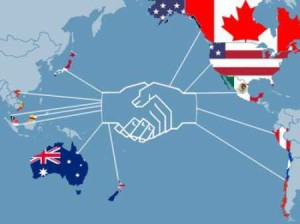 In early October news about the signing in Atlanta of a new global-scale trade agreement creating the Trans-Pacific Partnership (TPP) spread around the world. The decision was made by twelve Pacific Rim countries: the United States, Australia, Brunei, Vietnam, Canada, Malaysia, Mexico, New Zealand, Peru, Singapore, Chile, and Japan. This agreement is believed to be the biggest treaty of this kind that the U.S. has signed over the last two decades. The present agreement is modeled after the North American Free Trade Agreement (NAFTA) uniting the U.S., Canada, and Mexico into a single market that has successfully operated for more than twenty years. The new free-trade zone in the Asia-Pacific region will account for around a third of the global economy.
In early October news about the signing in Atlanta of a new global-scale trade agreement creating the Trans-Pacific Partnership (TPP) spread around the world. The decision was made by twelve Pacific Rim countries: the United States, Australia, Brunei, Vietnam, Canada, Malaysia, Mexico, New Zealand, Peru, Singapore, Chile, and Japan. This agreement is believed to be the biggest treaty of this kind that the U.S. has signed over the last two decades. The present agreement is modeled after the North American Free Trade Agreement (NAFTA) uniting the U.S., Canada, and Mexico into a single market that has successfully operated for more than twenty years. The new free-trade zone in the Asia-Pacific region will account for around a third of the global economy.
The news was met with a mixed reception in economic and political circles, and provoked many heated discussions. Suffice to mention that Democratic presidential candidate Hillary Clinton has spoken out sharply against the Trans-Pacific Partnership trade deal. At the same time, in order to support the talks and get the treaty signed, the Republican-controlled Congress passed a law giving President Barack Obama “fast-track” authority to conclude international agreements. It is, therefore, easy to conclude that this truly global agreement is strategically important for the U.S. economy.
In Russia, anti-American passions are running high, since this agreement is seen as having an anti-Russian and anti-Chinese character, and as being specifically directed against the alliance between the two countries. However, the idea of a Trans-Pacific free-trade zone first emerged in 2003 on the initiative of New Zealand, Singapore, and Chile–not the United States. In 2005, the aforementioned countries were joined by Brunei, and the agreement to create the TPP was signed under WTO’s rules. In 2008, the United States and other participating countries became interested in this project. The TPP agreement has been in a negotiation process involving twelve nations for more than five years, and despite the obvious success that was achieved in Atlanta, it has a long way to go yet. Russia and China have all the opportunities to join this process, but are obviously in no haste to do this.
Russian experts and analysts argue about the TPP’s consequences for Russia. It is evident that Russian exporters will face a tougher competition in the region when supplying goods–mostly raw materials–to TPP countries. According to the Peterson Institute for International Economics (PIIE), Russia’s GDP might fall by around $2 billion. In all, goods amounting to $5 billion per year are in the risk zone. These include aluminum, nickel and their alloys exported to Japan, Singapore, the U.S. and Mexico; fertilizers exported to Malaysia; crabs exported to the U.S.; and timber exported to Japan. Russia’s competitors that have joined the TPP– Australia, New Zealand, Malaysia, Canada and Chile–will find themselves in a better position as far as these exports are concerned. At the same time, some experts are saying that there are no risks for Russia, since it has no competitors in the Asian region when it comes to several exports, including palladium, platinum, carbamide, some types of rubber, plywood and fertilizers. Particularly as export revenues are bound to increase because of the collapsed ruble and lower production costs.
Instead of actively participating in the talks, the Russian authorities have adopted the role of an observer. Thus, at the 2011 APEC meeting, Dmitri Medvedev, at that time Russia’s president, said the following: “I don’t yet fully understand what will become of the Trans-Pacific Partnership. Once it is operational and brings results, then I’ll be able to say whether this club is interesting for us, and then we’ll be able to decide whether it is good or bad that we are not part of it. For now, it is only a project. Albeit an interesting one, for sure. We’ll have to see.”

Few people today remember that the Russian Far East -U.S. West Coast Working Group, which later became the Russian-American Pacific Partnership, was launched back in 1994. The group included representatives from thirteen regions of eastern Russia and five U.S. West Coast states. The group’s meetings were held annually, both in the U.S. and in Russia. Ironically, the 20th meeting of the partnership took place on the Sakhalin Island on October 7, 2015–two days after the TPP agreement was signed. But this time, no American representatives took part…
The Kremlin’s attitude toward the Trans-Pacific Partnership is a telling example of how the federal government nullified the two decades-old efforts by Russia’s eastern regions to create effective mechanisms for international cooperation in the Pacific. It appears that the Kremlin has little understanding of what is happening in the Russian Far East, and how people live there. As a result, Sakhalin, Vladivostok, Nakhodka and Shikotan are doomed to remain faraway Russian backwoods that have been–either intentionally or through negligence–excluded from a dynamically developing Pacific club.





